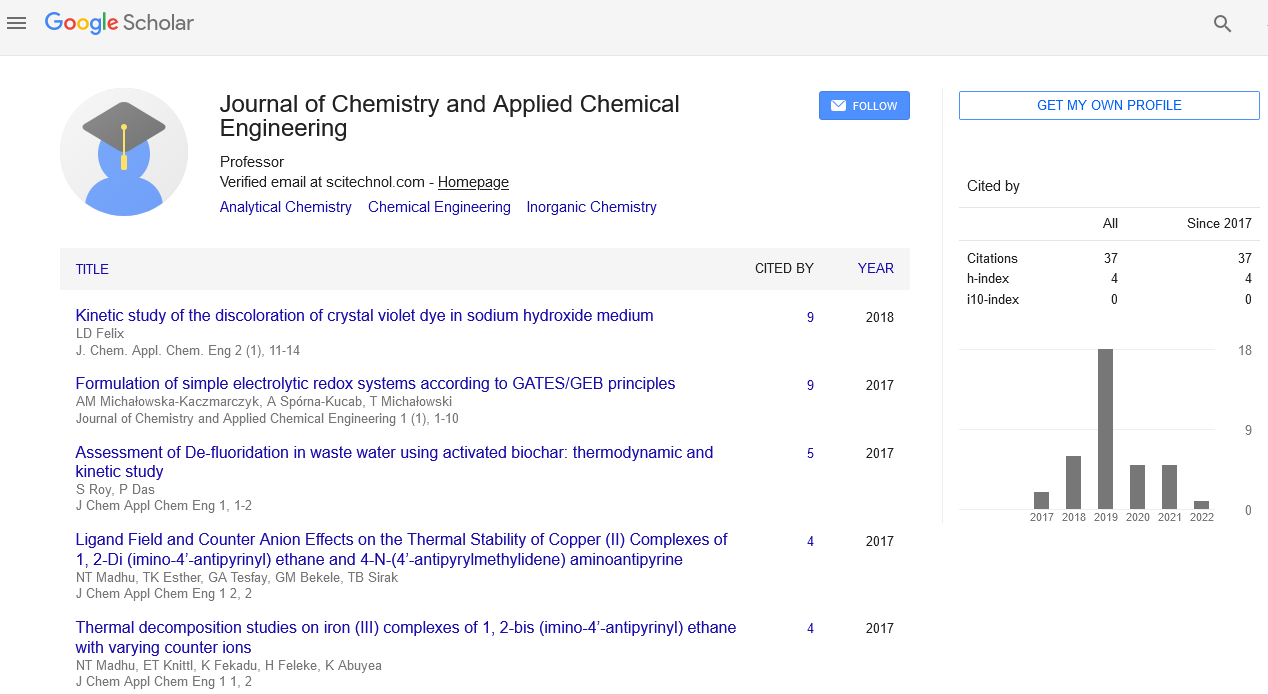Nanomaterials as effective adsorbents for removal of heavy metals from aqueous solutions
E K T Sivakumar
Anna University, India
: J Chem Appl Chem Eng
Abstract
The presence of heavy metals ions water as contaminant is a serious concern for human society due to their toxicity to many life forms. In recent years, rapid industrialization leads to contamination of major waste resources results in metal pollution in natural water. The heavy toxic metals entered into the water bodies through waste water form metal plating industries and industries of Ni-Cd batteries, phosphate fertilizer, mining, pigments and stabilizer alloys. Unlike organic pollutants, which are susceptible to biological degradation, metal ions do not degrade into any harmless end products and tend to accumulate in living organisms, causing serious disorders. With the development of nanotechnology, nanomaterials are used as adsorbents for the removal of heavy metals ions from water due to their unique structural properties. Compared to traditional materials, nanostructured materials have exhibited much high efficiency and faster rates in water treatment. There are various technologies have been developed over the years, the most important include chemical precipitations, electro floatation, ion exchange, reverse osmosis and adsorption. Most of these methods suffer from some drawbacks such as high capital, operation cost and the disposals of the residual metals sludge which are not suitable for small scale industries. Considering limitations of conventional methods for metal removal, the most promising alternative method appears to be the adsorption method. The adsorption method is exclusively used for the water treatment and the process is mainly chemicophysically feasible process. Also, this method is a used friendly cost effective process for the removal of metallic micro pollutants from water. The adsorption technique is superior to other techniques for re-use in terms of the initial cost, simplicity of design, ease of operation and insensibility to toxic substances. In this investigation, nanoferrites and their polymeric nanocomposites are used as adsorbents for removal of certain metals ions from aqueous solutions.
Biography
E K T Sivakumar has completed his PhD in chemistry from University of Madras. He has experience of research & development scientist for nearly two decades in Amrutanjan Health care (R&D) in India. He has received “scientist of the year 2008” award in a national level from National Environmental Science Academy (NESA), New Delhi, India for significant contribution in the field of science and technology. He is specialized in the synthesis and characterization of nanomaterials for various technological applications. He has authored 25 books for scientific awareness among society. He is an editor of Valarum Ariviyal- scientific magazine. He is recipient of number of outstanding awards for the contribution of Science, Education and Social activities. He is the founder of educational and social research organization and founder of ESR foundation. He has published more than 25 papers in reputed journals and has been serving as an editorial board member of reputed journals. He is a fellow of the Indian Chemical Society, member of the National Environmental Science Academy and a member of Indian Science Congress. Currently, he is working as visiting professor at Centre for Nanoscience and Technology, Anna University, India. He is en expertise handling theory for M. Tech and PhD students were the subjects are physics and chemistry of material, synthesis and analysis of nanomaterials, physicochemical methods for characterization of nanomaterials, MEMS and Bio MEMS, imaging techniques for nanotechnology, Processing and properties of Nanostructured materials. Also, he is guiding for the research projects and consultant and advisor for many industry- university interaction program.
E-mail: ektsiva1@hotmail.com
 Spanish
Spanish  Chinese
Chinese  Russian
Russian  German
German  French
French  Japanese
Japanese  Portuguese
Portuguese  Hindi
Hindi 